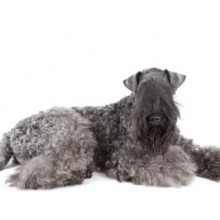Kerry Blue Terrier
Lifestyle Needs

The Kerry Blue Terrier is a compact, medium sized dog – a breed free from exaggerated features. His coat is soft, silky and does not shed. However the Kerry Blue’s coat does need to be groomed regularly to keep it clean and in good condition. The coat will gradually change from black to blue during the first year and a half of his life. The breed is suitable as a family dog – happy to live in any sized house but would prefer a garden to rummage in. He is fond of outdoor activities, typically likes water, and needs plenty of exercise.
Genetic Diversity
(Known as Coefficient of Inbreeding: 'COI'. It should be as low as possible.)
The UK Kennel Club breed average COI is 13.2% - See 'A Beginners Guide to COI'
Gene Pool Size
(Known as Effective Population Size: 'EPS')
42.60
EPS is a measure of how many individuals are contributing genetically to a breed population. It is a measure of the size of the gene pool in a breed. Lower than 100 is considered critical by conservationists and below 50 brings a breed close to extinction. For more information see the Kennel Club article.
Health and Welfare Problems due to Conformation
(Body shape and physical characteristics)
- Hair may cause problems when it falls into the eyes
- Excess hair in the ears can cause an accumulation of wax and predispose to ear infections
BVA/KC Health Schemes: www.bva.co.uk/chs
- Hip dysplasia: breed 5 year mean score 12 (parents should be lower)
- Elbow dysplasia: score ideally 0:0
- Eye disease
Estimated Breeding Values (EBVs) : No EBVs are currently available for this breed
www.thekennelclub.org.uk/about-ebvs
DNA Tests Available
DogWellNet and IPFD Harmonisation of Genetic Testing for Dogs (HGTD)
www.dogwellnet.com/breeds
- Von Willebrands Disease (vWD) Type 1
- Degenerative Myelopathy (DM)
Availability of a DNA test does not mean that it is always necessary or even desirable for breeders to use this test.
Other Breed-Specific Health Screening Schemes
None known
Ask the breeder to show you the certificates for the above tests/screening for both parents. If any of the above tests have not been considered necessary by the breeder (and there may be good reasons), ask her to explain why.
Other Diseases Reported
(For which there are currently no genetic or screening tests for sire or dam)
- Cutaneous neoplasia
- Footpad hyperkeratosis
- Canine multiple system degeneration
- Cataract
- Entropion
- Cancer
- Macrothrombocytopenia
Ask the breeder about the medical history of the parents, grandparents and great grandparents. Consider carefully whether to purchase a puppy if some of these or other diseases are in the family line.
Ask about the breeder’s policy in cases of serious genetic diseases occurring to your puppy in later life. Good breeders will request to be informed of such events in order to improve future breeding decisions.
You are strongly advised to buy from a breeder who uses (or is prepared to use) the AWF Puppy Contract and Puppy Information Pack (PIP): www.puppycontract.org.uk
The breeder should also be familiar with the CFSG/DBRG Code of Practice for Dog Breeding